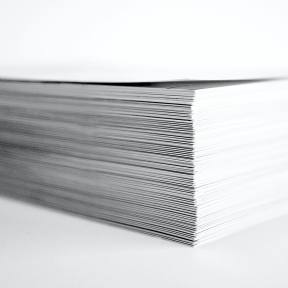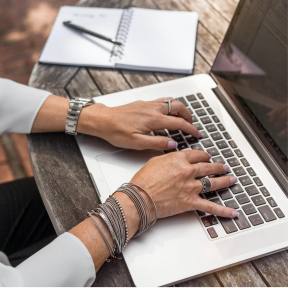
Business Letter Template — Free Download
Use our Microsoft Word downloadable template to correctly format your business letters.
Download NowHow to Write a Business Letter:

A step-by-step guide on how to write a business letter.
Prepare your document before writing.
Format the letter.

The most common layout for a business letter is known as block format, where the entire letter is left-justified and single-spaced, with a double space between paragraphs. Business letters typically have 1-inch (25.4 mm) margins on all sides of the page.
The generally accepted font is Times New Roman, 12 pt., although other fonts like Arial are sometimes used.
Consider the style of the company you are addressing when choosing a font.
Choose the appropriate paper to print on.

A business letter should be printed on "letter size" paper, which is 8.5" by 11" in size. Outside the U.S., you can use paper size A4. For a lengthier contract, you can use 8.5" by 14" paper, otherwise known as "legal size."
Print your business letter on your company's letterhead. This will provide a more professional appearance as well as providing your company's contact information.
Begin crafting your business letter.
Type out your company information.

This goes in the top left-hand corner of your page, with each part of the address written on a new line. You should not include your (or the sender's) name or title as you will list that information in the closing.
If you are sending your letter to an international company, be sure to type out your country in capital letters.
Type the date.

Leaving an open space after your company information, type out the date in full for a more professional look. If you took a couple of days to write your letter, use the date on which you finished. When writing to a recipient within the U.S., use the American date format: month, day, year.
Add the recipient's information.

Leave a line open after the date and add your recipient's full name, title (if applicable), company name, and address. Type out international recipients' countries in capital letters on the last line. Each piece of information should appear, in this order, on a separate line. You may also include a reference number, if necessary.
Address your letters to a specific person. If you don't know their name, do some research or call the company.
Choose an appropriate salutation.

Finally, and after leaving another line open after your recipient's information, choose an appropriate salutation depending on the person you are writing to, how well you know them, and how formal your relationship is.
Write the introduction.

Start your letter with a short introductory paragraph. It should include a friendly but professional opening and the main point(s) of the letter.
Compose the body of the letter.
Write the letter.

In a formal yet friendly tone write the body of your letter. The first paragraph can include a friendly opening but should focus on a statement of the main point. The second paragraph should justify the importance of the main point. Each subsequent paragraph should continue the justification with background information and supporting details. The closing paragraph should restate your main point and request action.
Keep it to one page if possible.
Refer to yourself as "I" and your reader as "you" to keep your letter concise and to the point. If you are writing on your company or organization's behalf, use "we" so that the reader knows your company is behind you.
Your last paragraph should summarize your points, your planned course of action, and what you expect from the recipient.
Close the letter.
Write the ending.

Choose an appropriate closing that is an indicator of respect and formality, and use a comma after your closing. Always use a positive closing, with only the first letter capitalized. Sign the letter.
Blue or black ink is the most common, and preferred, choice for signing a business document.
Add your information.

After the signature block, type in your name, title, phone number, email address, and any other appropriate means of communication. Each piece of information should be in its own line. Do not include your company's address as it is at the top of the page.
If you did not type the letter, the typist's initials should be added next in lower case.
Include any enclosures.

For any additional documents added to your letter, note the number and type of documents beneath your contact information. For example, "Enclosures (2): brochure, market analysis." This ensures the reader does not miss any important information.
If you are sending the letter to another person, you should include this information. Type "cc:" below the enclosures with the person's name and title.
If you are sending the letter to more than one person, align the second name under the first, but without the "cc".
Edit.
Carefully edit your letter.

Be sure to check spelling, punctuation, grammar, and professional appearance. You can run spell check but also read through your letter as spell check does not catch all nuances.
Having a colleague read through the letter can help.
Additional Tips Before Sending a Business Letter:
- Make sure your letter is clear and concise.
- Paragraphs should be three to four sentences long.
- Do not staple letters that are more than one page. If you want to keep your pages together and in order, use a paperclip at the top left corner.
- Time-sensitive letters can be sent through courier or by email.
- If emailing, save your letter as a PDF to preserve the formatting.
Types of Salutations:
Salutation | Description |
|---|---|
To Whom It May Concern: | Used when you don't know who to address the letter to, for example, when writing to an institution. |
Dear Sir/Madam: | Used when writing to a position that you don't have a named contact for. |
Dear Mr. Smith: | Used when you have a named male contact. |
Dear Ms. Smith: | Used when you have a named female contact to encompass all marital statuses. Don't use the traditional Mrs. |
Dear Dr. Smith: | Used when you are writing to a named doctor. |
Dear Prof. Smith: | Used when you are writing to a named professor. |
Dear Kris Smith: | The whole name is used when you are unsure of the recipient's gender. |
Dear Colleagues: | Used when writing to a group of people. |
Dear Jane: | Used when writing to a named female contact that you have a less formal relationship with. |
Dear John: | Used when writing to a named male contact that you have a less formal relationship with. |
Different Ways to Start a Business Letter:
1. Referencing previous contact:
- I am (we are) writing regarding...
- In reply to your request...
- Thank you for contacting us.
2. Contacting for the first time:
- I am (we are) writing to inform/confirm/enquire/complain...
- I am contacting you for the following reason.
- I recently heard about ... and would like to ...
3. Making a request:
- We would appreciate it if you would...
- I would be grateful if you could...
- Could you please send me...
- Could you possibly tell us...
- It would be helpful if you could send us...
4. Giving good news:
- We are pleased to announce that...
- I am delighted to inform you that...
5. Giving bad news:
- We regret to inform you that...
- I'm afraid it would not be possible to...
- Unfortunately, we are unable to...
- After careful consideration, we have decided...
Types of Closing:
Closing | Description |
|---|---|
Yours sincerely, | Used when To Whom It May Concern or Dear Sir/Madam has been used as a salutation. |
Sincerely yours, | Used when To Whom It May Concern or Dear Sir/Madam has been used as a salutation. |
Respectfully, | Used when To Whom It May Concern or Dear Sir/Madam has been used as a salutation. |
Sincerely, | Used when Dear Name has been used as a salutation. |
Kind regards, | Used for less formal situations, but still businesslike. |
Warm regards, | Used for less formal situations, but still businesslike. |
Regards, | Used for less formal situations, but still businesslike. |
Best wishes, | Less formal. |
Different Ways to End a Business Letter:
1. Enclosures:
- Please find enclosed... (for letters).
- Please find attached... (for emails).
2. Offering future assistance:
- If you require more information, please let us know.
- Please do not hesitate to contact us if you need any further assistance.
3. Referring to future contact:
- I am looking forward to hearing from you soon.
- We are looking forward to meeting you on [date] in [town/city].
- We would appreciate your reply at your earliest convenience.






